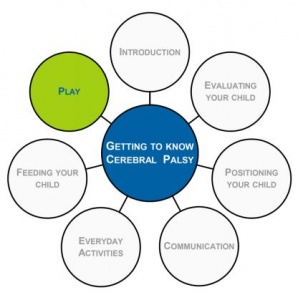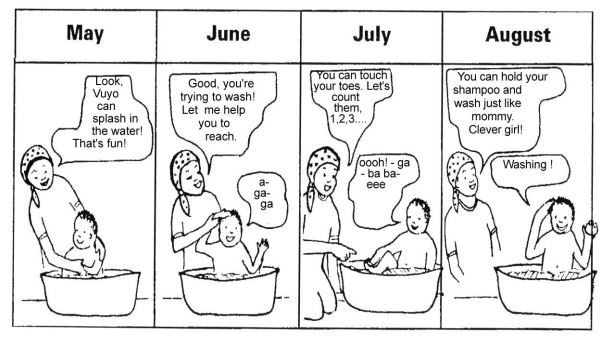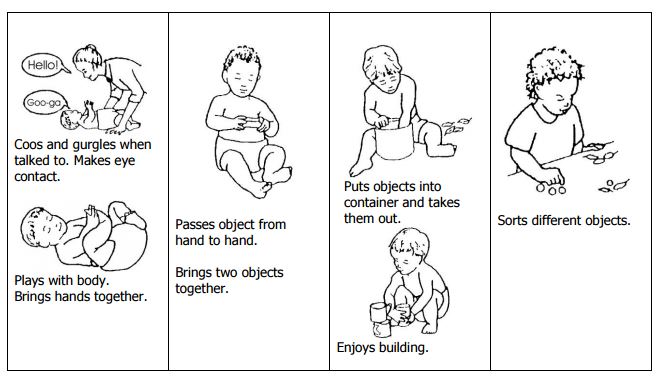When you have finished this workshop, you should be able to:
- Understand and explain to other caregivers the importance of play for a child’s development.
- Help your child with cerebral palsy to enjoy times of play that promotes her communication, movements, social and emotional skills, and learning.
Play is any activity that a child CHOOSES to do, and has FUN whilst doing. Through play, a child uses her SENSES to explore and learn.
Senses:
- Seeing
- Hearing
- Touching / Feeling
- Smelling
- Tasting
Something else that works very closely with our senses, and is involved in play, is movement.
Examples of play:
- Enjoying the sound of a rattle/music (hearing)
- Looking at something that is shiny or colourful or pretty, or mom’s face (seeing)
- A baby kicking her legs and laughing (movement)
- Handling different objects – soft, hard, prickly etc (touching / feeling)
- Playing “peek-a-boo” (seeing)
- Splashing in water (feeling and movement)
- Hide and seek (hiding an object under a lid or box and getting the child to try and lift the box to find the object, or hiding yourself from them and seeing if they can move or look for you (seeing)
- Pretending to make food out of mud (touching or feeling)
- Swimming or spinning around in circles (movement)
- Singing & clapping games (sight, movement, hearing)
- Running around (movement)
- Playing soccer or other sports (sight, movement, feeling)
This child is playing and learning:
- It gives her opportunities to explore and therefore learn about things in her environment.
- It gives her opportunities to use and develop her senses.
- It gives her a reason to practice moving (when she is having fun she will be motivated to move).
- It gives her opportunities to interact with other people and learn social skills.
- It gives her opportunities to think and learn.
Remember:
- A child in a poor position, and without play and communication, will not develop and learn.
- A child who is not enjoying the activity because she can’t do it, will not develop and learn.
Children need help to play[edit | edit source]
To learn to play, all children need the encouragement of their parents, siblings and other people.
Children with cerebral palsy also need encouragement, and may need special help and attention.The caregivers of a child with cerebral palsy need to encourage her to be active in play situations, and they need to help her to learn.
Play is more important than toys. Almost anything can be used as a toy, if it is used in play.
Simple toys that you can make at home[edit | edit source]
Let’s look at a variety of simple toys that you can make at home for your child. For each toy, we will briefly discuss how you can make it, and then think about which children would benefit from such a toy, and how you can use it to play with them.
|
Rattles
Making it:
- Plastic bottle / tin or bamboo
- Stones or seeds or beans or rice to put inside
- Lid or cork to close the hole
Using it:
- Hold it a short distance away from the child’s face and encourage her to look towards the sound and movement when you shake it. Shake the rattle for a bit then wait for the child to react before shaking it again. Don’t shake it continuously. Encourage her to move her head towards the sound.
- Help her to hold the rattle, and encourage her to move her arm to make the rattle make a noise.
- Help her to practice holding and letting go of the rattle (taking it from someone, giving it to someone else).
- If the child drops or throws her toys, try attaching strings and help her learn to get them back by herself.
|

|
|
Mobiles
Making it:
- Tinfoil / CDs/ bottle tops
- Beads or seeds
- Bells
- Brightly coloured material
- Egg boxes
- Hang any shiny object or something that moves easily in a gentle breeze (eg tissues).
Using it:
- Hang above the child when she is lying on her back or on her side – she can enjoy watching the objects, and may try to reach and take them so that she can feel them, or make them move to hear the sound (eg bells).
|

|
|
Vision-box
Making it:
- Cardboard box
- Mobiles – placed above her waist; not more than 3 objects. These can be shiny things (like an old CD or pieces of foil), brightly coloured beads, or light pieces of material that will move with a gentle breeze or blowing.
Using it:
- The child lies on her back with her head and upper body inside the box.
- This can be used for a child who cannot see well. The dark box with the shiny or brightly coloured mobiles may help her begin to use and train her eyes.
- She will enjoy looking at the bright or shiny colours, or watching the light material blow in the wind.
|
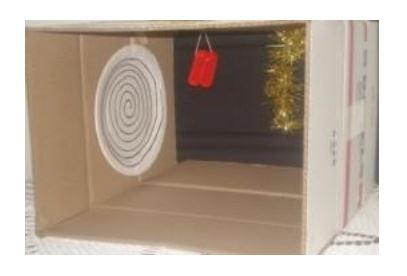
|
|
Texture bag/box
Making it:
- Material of different textures – soft; silky; corduroy; woolly; embroidered; netting
- Piece of steel wool or plastic hair curler (scratchy feeling)
- Something hard – marbles, steel teaspoon, glass bottle
- Soft toy – teddy bear
- Clothes peg
- Plastic packet or noisy paper
- Seeds or pods of different textures – smooth, rough etc.
Using it:
- This is especially good for children who have problems seeing well, and for those who do not move easily by themselves.
- Help the child to feel the different textures on the outside and inside of her hand. First work on the outside of her hand – then open her hand and let her feel it on the inside of, or put it in her hand.
- A child who can move her hands can practice taking and giving the objects.
|
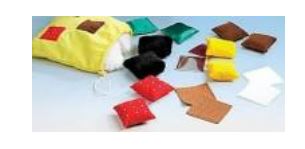
|
|
Drum
Making it:
- Can or plastic container or pot
- Stick or wooden spoon or metal spoon
Using it:
- Help the child to hold the stick and to play the drum (involve the family and get others to sing with her. Involve the child in family or church gatherings where there is music or singing)
- Encourage the child to hold the sticks by herself if possible
- Encourage her to move her arm by herself to hit the drum
|
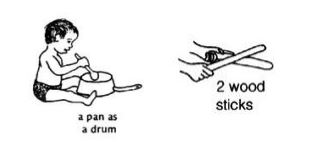
|
|
Push/pull rattle
Making it:
- Use a tin or plastic container that has a lid
- Make a tiny hole in the lid and bottom of the tin
- Put some small stones or seeds into the tin
- Use a wire hanger to make a rectangular loop through the holes
Using it:
- Help / encourage the child to hold the wire and push the toy away and pull it back towards her
- Encourage her to walk / crawl while pushing the toy
|
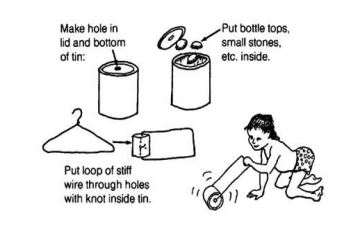
|
|
Making it:
- Large tin or plastic container
- Small items (seeds, bolts, match boxes, stones, small plastic cups, scrunched newspaper balls, bottle tops or lids).
Using it:
- Encourage the child to pick up the small objects one by one
- She can take them out of the container, and put them back in
- Encourage her to talk about what she is doing – “in” and “out”.
|
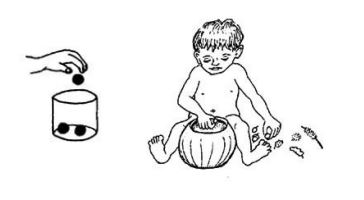
|
|
Stacking poles
Making it:
- Wooden base with stick or small poles or long paper towel rolls
- Rings (cut holes into plastic lids, make ring out of foil, soft branches, woven grass, cut up toilet rolls)
- Blocks (out of cardboard from empty boxes or scrap wood) – make a hole in the centre.
- Using it:
- Help the child to take a ring or block and place it on one of the rings
- If there are different types of rings, help the child to match the ones that look the same
- Encourage the child to count the rings as she puts them on.
|
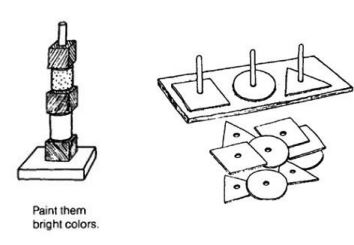
|
|
Posting Making it:
- Plastic container or tin with plastic lid and shaped holes cut out
- Find small objects, and cut the holes in the lid to the same size & shape – use bottle tops, match boxes, small lids, pieces of wood.
- Simple toy – objects and holes are all one shape
- Complex toy – objects and holes are a variety of shapes
Using it:
- Encourage the child to post the object into the correct shape and size hole.
- Help her to pick up and let go of the objects (if she has difficulty using her hands). Let her guide the object into the hole she wants to put it in. Talk to her about the size and shape of the different objects as she plays.
|
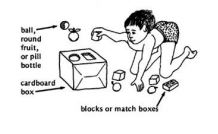
|
Guidelines for children who have difficulty hearing or seeing[edit | edit source]
- If a child has been diagnosed with blindness or deafness, focus on other senses for play.
- However, unless a medical person has told you that a particular sense is not working at all (eg hearing or seeing), try to practice the sense through play by giving opportunities to use that particular sense eg shiny mobile or vision box for a child who has difficulty seeing.
|
Visual rattle
Making it:
- Plastic bottle filled ¾ with water, dishwashing liquid or something to make bubbles, small plastic beads or seeds that are brightly coloured or dark.
- Using it:
- Use it the same way as the rattle discussed earlier in the module.
|
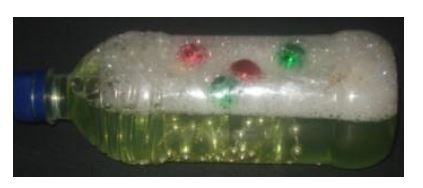
|
|
Other musical instruments
Making it:
- Bottle tops on a piece of wire
- Container with small stones or seeds
Using it:
- Help her to hold and play the instrument
- Encourage her to take and let go by herself
- Encourage her to move her hand or arm by herself so that the instrument makes a noise
|
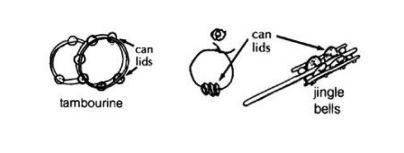
|
|
Soft toy rattle
Making it:
- Small bottle with seeds or stones inside
- Material cut out into shape (ball, animal, bear)
- Stuffing
- Needle and thread to sew it together
Using it:
- Encourage the child to hold, touch and handle the toy
- Show her that if she shakes it, it makes a sound.
- Encourage her to shake it by herself.
|

|
|
Bath toys
Making it:
- Visual rattle
- Plastic cups / small bowls or anything that floats on water
- Add something that will make some bubbles (eg dishwashing liquid).
Using it:
- Encourage the child to splash in the water and move her arms or legs by herself to move the objects
- Help her to fill the plastic cups with water, and then pour it out. Or use one cup to fill another cup with the water
- Splash to make bubbles.
|
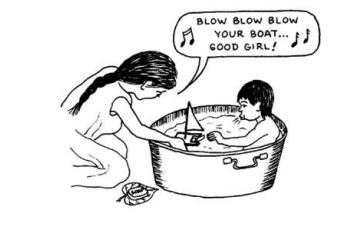
|
|
Blocks
Making it:
- Pieces of scrap wood cut into different shapes
Using it:
- Encourage the child to hold the blocks and build different structures out of them
|
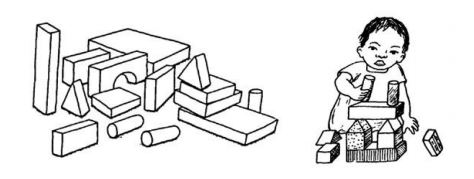
|
|
Form board/puzzels
Making it:
- Use firm cardboard or hardboard for the base
- Use firm corrugated cardboard, with shapes cut into it, for the top part
- Use small pegs for holding to get shapes out
- Puzzle – use firm cardboard cut into shapes.
Using it:
- Encourage the child to pick up the pieces herself
- Encourage and help her to match the shape of the piece to the correct hole
- The child will learn by trying to fit the piece herself – don’t always show her the right hole immediately.
- Let her make mistakes and try again.
|
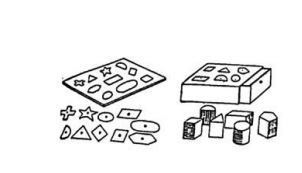
|
|
Car Making it:
- Plastic bottle – one side cut out to make a “convertible”
- Straight sticks for wheel axles
- Plastic bottle tops or cut out plastic rounds or pieces of a round wooden branch for wheels.
Using it:
- This toy will allow the child to use her imagination while playing
- Encourage her to use sounds (and words if possible) while she plays (making the sounds of a car).
|

|
|
Peg board – poles or clothes pegs Making it:
- Wooden or thick cardboard base with notches in it
- Round pegs to put into the notches (you can also use clothes pegs)
Using it:
- Help the child to practice using her fingers by picking up small things
- Encourage her to put the pegs into the correct sized holes.
|
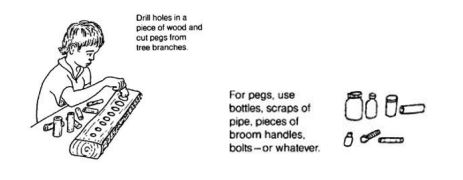
|
Hambisela_Module_7_Play
Ideas from many sources have helped us to develop the Hambisela programme. The following material and references have been particularly helpful, either as sources or as inspiration on how to present training, and we gratefully acknowledge their use.
In many cases we have been given permission to use photographs. Where permission could not be obtained, the faces have been re-touched in order to protect identity.
1. “Disabled Village Children – A guide for community health workers, rehabilitation workers, and families”, David Werner, The Hesperian Foundation, Berkeley (1999).
2. “Promoting the Development of Young Children with Cerebral Palsy – A guide for mid-level rehabilitation workers”, World Health Organisation, Geneva (1993).
3. “Let’s Communicate – A handbook for people working with children with communication difficulties”, World Health Organisation, Geneva (1997).
4. “Community Based Rehabilitation -- Training and Guide”, World Health Organisation, Geneva (1989).
5. “Cerebral Palsy, ga se boloi (it’s not witchcraft)”, Physiotherapist Department of Gelukspan Center, Reakgona.
6. “Polokwane Hospital CP Group Manual”, Polokwane Hospital.
7. “Community-Based Rehabilitation Workers – a South African training manual”, Marian Loveday, SACLA Health Project, Cape Town (1990).
8. Foden Manuals 1-4, Foden Centre, East London (1999).
9. “Practicing the new ways of feeding your child at home”, Diane Novotny, Speech, Language and Feeding Therapist, Western Cape CP Association & Red Cross Children’s Hospital, Cape Town (circa 2006)
10. “Learning for Life”, Masifunde 2002, Staff Development Special Care Centres, Cape Mental Health.
11. “The Education of Mid-Level Rehabilitation Workers”, World Health Organisation, Geneva (1992).
12. “Disability Prevention and Rehabilitation in Primary Health Care – A guide for district health and rehabilitation managers”, World Health Organisation, Geneva (1995).
13. “Disability Prevention and Rehabilitation – A guide for strengthening the basic nursing curriculum”, World Health Organisation, Geneva (1996).
Hambisela Project - Cerebral Palsy
